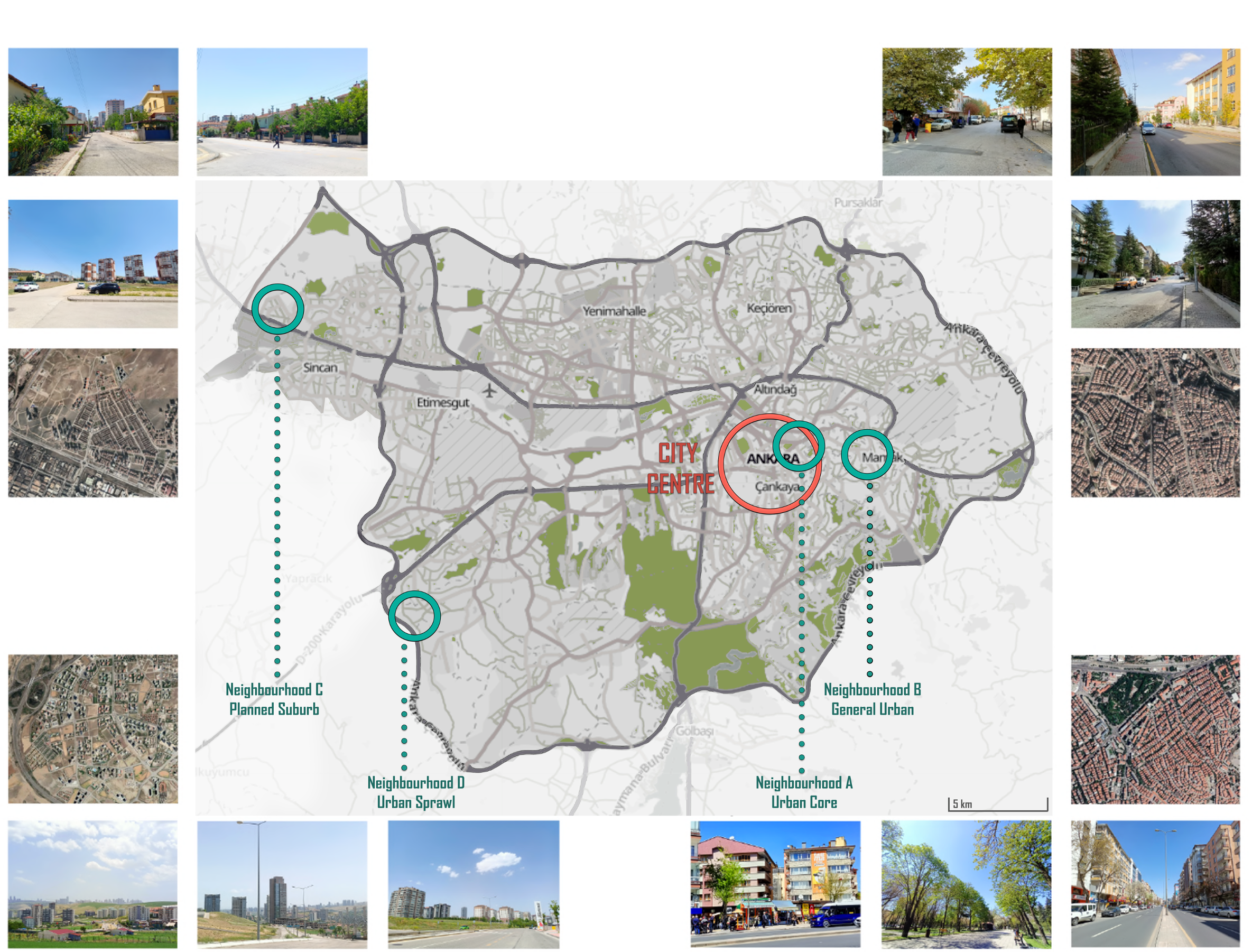Neighbourhood Design and Children in Ankara, Turkey
This study was carried out in a developing country and an understudied region: Ankara, Turkey. This study focuses on Ankara, Turkey, and its selected neighbourhoods. The city is the second largest in Turkey with an area of 24,521 km2 and an estimated population of 5.6 million, approximately 287,000 of which are school year-aged children. Neighbourhoods with varying street network designs (spanning from highly connected with mostly a grid-iron layout to less connected with dead-ends) and neighbourhood greenness were targeted to explore how diverse neighbourhoods might have different influences on children’s physical activity (PA). Accordingly, we selected four neighbourhoods: one from the urban core, one from the general urban, one from the suburban and one from a sprawling area (Figure 1).

Figure 1: Neighbourhoods selected for the study
Five public schools were selected from the four neighborhoods. After acquiring the ethics approval from METU and Ankara Education Directorate, we recruited 50+ children from each neighborhood residing within a 20-minute walk of the schools. Data collection proceeded after receiving informed consent/assent. We recorded children’s home postcodes, demographics on consent forms, and anonymized names for confidentiality.
We collected and synthesized data through the application of several methods:
- Children’s Survey. Data was gathered using validated surveys assessing mental wellbeing and life satisfaction among children aged 8-18. The “Me and My Feelings Survey” and “Students’ Life Satisfaction Scale” were administered in classrooms under teacher supervision.
- Parental Questionnaire. Parental questionnaires collected data on family demographics, income, education, car ownership, children’s school commute, and health issues via participating children.
- Activity Diary and Pedometer Activity. Children were asked to fill out an activity diary and carry a pedometer for a week.
- Focus Groups with Participatory Mapping. Children marked their homes and activity locations on a satellite map, explaining their preferred everyday activity spaces using colored stickers in school-based focus groups of up to 5.
- Urban Form Analysis. Children’s home environments were assessed using GIS for land use, density, street design, and greenness within 400 and 800-meter radii, utilizing high-resolution spatial data. Field surveys and spatial analyses, including GIS and space syntax, were conducted to analyze neighborhood built environments.
Out of 271 children in the study, 20% living beyond the school’s vicinity were excluded. Analysis continued with 217 children: 53 from urban core (62% female), 55 from general urban (54% female), 48 from sprawling area (50% female), and 61 from suburban (44% female). Median household incomes ranged from US$550-800 (middle-income) to US$0-550 in other areas (low-income).
All data was transcribed in ArcGIS and analysed quantitatively (statistical analyses using SPSS) and qualitatively (hot-spot mapping and thematic analyses using MAXQDA.
Related Publications
Ozbil Torun, A., Severcan, YC., Defeyter, MA., Akin, Z., Bingol, H. (2023). “Learning from Children: design and policy insights for child-friendly neighbourhood design”, Development Studies Association (DSA) Conference, 28-30 June, Reading. (https://www.youtube.com/watch?v=hpL2cNU2w-g)
Severcan, YC., Ozbil Torun, A., Defeyter, MA., Akin, Z., Bingol, H. (2022). “Understanding the Role of the Urban Form in Supporting Positive Experiences and Increased Mental Well-being among Children”, Urban Transitions Conference, 8-10 November, Barcelona.
Severcan, YC., Ozbil Torun, A., Defeyter, MA., Akin, Z., Bingol, H. “Associations of children’s mental wellbeing and the urban form characteristics of their everyday places”, under review.
Ozbil Torun, A., Severcan, YC., Defeyter, MA., Bingol, H., Akin, Z. (2023). “Neighbourhood design and identification of objective built environment features supportive of children’s mental wellbeing”, in the proceedings of the 13th Space Syntax Symposium, 20-24 June 2022, Bergen, Norway. (chrome-extension://efaidnbmnnnibpcajpcglclefindmkaj/https://www.hvl.no/globalassets/hvl-internett/arrangement/2022/13sss/478torun.pdf)
Severcan, YC., Ozbil Torun, A., Defeyter, MA., Akin, Z., Bingol, H. “Environmental Predictors of Children’s Mental Wellbeing in Ankara” , under review.
Akin, Z. Ozbil Torun, A., Severcan, YC., Defeyter, MA., Bingol, H., (2023). “Assessment of Urban Planning and Design Guidelines for Creating Child-Friendly Environments: What Can We Learn From Children? “, AESOP Annual Conference, 11-15 July, Lodz, Poland.
